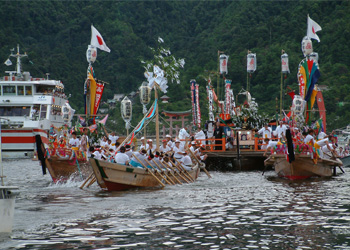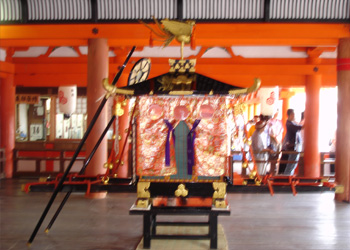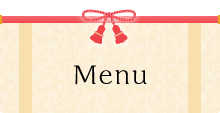Kangen-sai | Events | Miyajima Tourist Association
This event originating during the Heian period (794 - 1185 AD), is the largest annual festival observed at Itsukushima Shrine, and takes place on the night of June 17th of the lunar calender.
| Date | Friday, July 11, 2025 ※June 17th by the lunar calendar |
|---|---|
| Location | Itsukushima Shrine and other shrines |
Festival Schedule
| 15:00 | Hatsurensai-Shinto ceremony at Itsukushima Shrine. |
|---|---|
| 16:00 | The portable shrine is moved to the Goza boat and the boats depart the shrine heading toward O-torii Gate. |
| 16:40 | Ceremonial Gagaku music is performed at the gate. After the performance, the boats sail toward Jigozen shrine. |
| 18:00 | At Hotateiwa, Eba's rowing boat is unfastened from the Goza boat and goes ahead to Jigozen Shrine to dedicate a dance performance. The Goza boat and Aga rowing boats are anchored there and have dinner and sacred sake in the boats. After sunset, they light the lanterns. |
| 19:20 | The boats get to the shore in front of Jigozen Shrine. Ceremonial Gagaku music is performed in front of the shrine. |
| 20:40 | When the boats get to the shore in front of Nagahama Shrine, people on Miyajima greet them with paper lanterns. Ceremonial Gagaku music is performed. After the boats leave for Goza boat is rotated three times by Eba's rowing boat and the boats leave for Omoto Shrine. |
| 21:30 | Ceremonial Gagaku music is performed on the shore in front of Omoto Shrine. |
| 22:30 | Ceremonial Gagaku music is performed in front of Marodo Shrine. The boats get into Masugata and rotate three times, playing Gagaku music. This is the grand finale of the festival. |
| 23:00 | The portable shrine is moved back to Istukushima Shrine. |
* Times are subject to change.
The origin of the festival
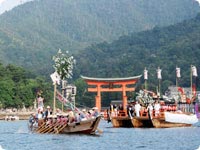
The Kangensai Festival reproduces a dynastic spectacle of the Monarchial Age on June 17th of the lunar calender, and has become one of the greatest festival of Itsukushima Shrine. When Taira-no-Kiyomori was appointed the governor of Aki Province in 1146, he remodeled Itsukushima Shrine and dedicated various kinds of treasure and performing arts to show his devout faith to the gods of the shire.
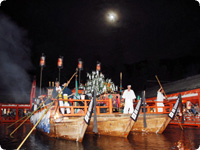
In those days, aristocratic entertainment or court music was often performed in the capital and Kiyomori introduces it to Miyajima. Kangen is, to be exact, court music played with three strings (Wagon, biwa ,koto), three drums (Kakko, taiko, shoko), and three flutes (sho, hishikiri, ryuteti).
Though in the capital, they played court music for entertainment, kiyomori dedicated it to Itsukushima Shrine, and instead of floating a Ryuto-gekishu boat (a boat with a carved dragon head and waterfowl neck decoration in front) in the court pond or in the river, he floated the boat in the sea.
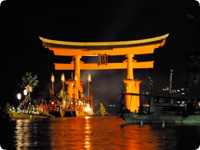
The date was fixed as June 17th of the lunar calendar, considering the weather conditions. As they needed big boats to carry a large number of players, they must have used trading vessels to China. The tide should be high enough for deep-draft vessels to touch down, so they chose the day when the spring tide occurs in June, avoiding the typhoon season in July and August. The reason they fixed the day as 17th is that the moon on that day is nearly full. It's the best time to come back from Jigozen Shrine on the mainland to Miyajima, looking up at the moon that appears by the edge of the mountain on Miyajima.









